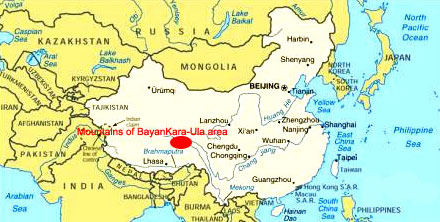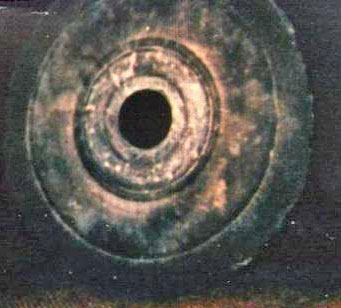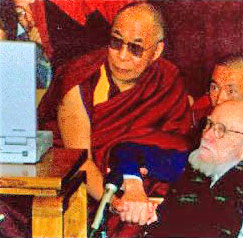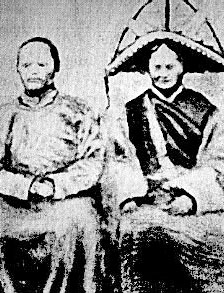|


from
UFOCaseBook Website
The Hunt
It all began in 1937-1938, in the mountains of Baian-Kara-Ula,
the remote, uninviting slopes located on the border that divides
China and Tibet. An archaeological expedition, led by the highly
respected Chi Pu Tei, discovered a number of unique cave
burial sites. What he and his team found in these previously unknown
caves would soon be considered as something highly unusual.

"click" image for
larger version
For many it would
represent one of the greatest discoveries of the century, and change
everything they perceived about their distant past and their origins
as a people. Those who believed in the Genesis of the Bible only saw
the so-called "scientific evidence" as possible proof of another
creation of God intruding into Mankind's domain. By faith, this
domain and any other living, thinking beings came from the one God
worshiped by Christian and Jew alike.
The Caves
Chi Pu Tei, a professor of archaeology at Beijing University,
directed the archaeological survey of a series of interlinking
caves. In a report he noted that the "caves" may have been
artificially carved, and were more like a complex system of tunnels
and underground storerooms. The walls were squared and glazed, as if
cut into the mountain with a source of extreme heat. Inside the
caves were several ancient, but neatly arranged burial sites, and in
them the skeletal remains of a people; a strange people.
The Skeletons
The skeletons, measuring a little more than four feet tall, were
found "frail and spindly" with "disproportionately large" skulls. At
first it was suggested that these might be the remains of an unknown
species of mountain gorilla. Fellow researchers initially ridiculed
Tei's published findings. The concept of gorillas burying their
young was preposterous, but that left one important question to
ponder: "What kind of human beings could these people have been?"
"Were they human at all?"
More discoveries made deeper in the connectiing caves eliminated the
possibility that apes had lived there. On the walls carved
pictograms of the heavens were found. The Earth, the sun, the moon,
and the stars were there, and all were connected by pea-sized dots.
It was obvious that the pictures were meant to be a map or chart of
some kind, and that they were created by intelligent beings.
The Discovery
 The
team then made what was called "the most incredible discovery of
all." Half buried in the dirt floor of each cave they found unusual
disks, originally referred to as "odd stone disks" and described as
"obviously fashioned by the hand of an intelligent creature." These
disks were approximately nine inches in diameter and three-quarters
of an inch thick. In the exact center was a perfectly round 3/4 inch
hole, and etched into its face was a fine groove spiraling out from
the center to the rim, making the disk look like some kind of
"primitive phonograph record." The
team then made what was called "the most incredible discovery of
all." Half buried in the dirt floor of each cave they found unusual
disks, originally referred to as "odd stone disks" and described as
"obviously fashioned by the hand of an intelligent creature." These
disks were approximately nine inches in diameter and three-quarters
of an inch thick. In the exact center was a perfectly round 3/4 inch
hole, and etched into its face was a fine groove spiraling out from
the center to the rim, making the disk look like some kind of
"primitive phonograph record."
One of the best preserved disks was dated to between 10,000 and
12,000 years BC old, older by far than even the oldest estimates of
the age of the great pyramids of Egypt. This was incredible news,
but what was to come would be even more remarkable. A final total of
716 such plates were found, and each held its own mystery. The
grooves, upon closer inspection, were not grooves at all, but a
continuous line of an unknown writing!
The Meeting
|

Dalai Lama with
Dr. Evans |
Shortly after World War
II, a Polish professor named Lolladoff showed one of the
'stone disks' to British scientist Dr. Karyl Robin-Evans, who
helped bring the story to the western world. Lolladoff
claimed to have bought the disk in Mussorie in Northern India
and that it was supposed to be from a mysterious people called the "Dzopa"
(or "Dropa") who had used it for religious rituals.
Robin-Evans would follow the trail of the Dropa to its origins, and
was able to take a rare photograph of the Dropa leaders in 1947
(below image). His
visit with the Dalai Lama was legendary, and provided a wealth of
information on the reclusive, unique tribe of people.
The Translation
Many experts tried to translate the hieroglyphs in the 20 years the
disc lay in Peking. They all failed. It was not until another
professor, Dr. Tsum Um Nui, broke the code and started to decipher
the 'speaking grooves' that the full implications of the disc were
realized. Realized, that is, only by a select few. The outside world
remained in ignorance. For the professor's conclusions on the
meaning of the disc were so shattering that they were officially
suppressed. The stone disks told an astonishing story of a 'space
probe' by the inhabitants of another planet which came to crash in
the Bayan-Kara-Ula mountain range. The strange, spiral script told
how the peaceful intentions of the 'aliens' had been misunderstood,
and how many of them were hunted down and killed by members of the
Ham tribe, who lived in the neighboring caves.
|

The Dropas ruling couple (1947)
Hueypah-La (4 ft. tall) and
Veez-La (3 ft. 4 in. tall) |
According to Nui, one of the lines of the hieroglyphs read,
"The Dropas came
down from the clouds in their aircraft. The men, women and
children of the neighboring peoples (Ham) hid in the caves ten
times before sunrise. When at last they understood the sign
language of the Dropas, they realized that the newcomers had
peaceful intentions...".
Another section of the
writings expressed 'regret' by the Ham tribe that the
aliens'
spaceship had crash-landed in such a remote and inaccessible
mountains and that there had been no way of building a new one to
enable the Dropas to return to their own planet. In the years since
the discovery of the first disk, archeologists and anthropologists
had learned more about the isolated Bayan-Kara-Ula area. Much of
what they learned seemed to corroborate the bizarre story recorded
on the discs. Legend still preserved in the area spoke of small,
gaunt, yellow faced men who 'came from the stars, long, long ago'.
The men had huge, bulging heads and puny bodies and were so ugly and
repellent that they were hunted down by local tribesmen on
horseback. Strangely, the description of the 'invaders' tallied with
the skeletons originally discovered in the caves by Professor Chi Pu
Tei.
As incredible as the Chinese disk story may be, there is more! On
February 26, 1967, the Los Angeles Herald-Examiner ran an article
about the Dropas. Part of it follows ...
The Riddle
"Riddle of Asian Stone Discs from Outer Space"
(original newspaper headline)
Russian archaeologists are puzzling over a remarkable collection of
stone discs, thousands of years old, found in the mountains
bordering China and Tibet. So hard is it to explain them in terms of
earthly experience that the archaeologists do not rule out the
possibility that the discs may have come from outer space.
A total of 716 discs, like Stone Age gramophone records have been
picked up in recent years by men exploring caves in the Bayan-Kara-
Ula mountain range, reports the Soviet Union's new English-language
magazine, Sputnik.
Each disc has a central hole and irregular grooves spiraling out to
the edge, but the report says (quite seriously) that the groves are
not sound tracks. It is thought that they are some form of ancient
writing, but scientists have so far failed to decipher them.
Chinese archaeologists estimate that the discs are about 12,000
years old, but have made no headway at all in trying to explain
their purpose or how they came to be in the caves.
The Russians, who have examined some of the discs in a
Moscow
laboratory, claim to have made two important discoveries. One is
that the discs contain certain traces of metal; particularly cobalt.
Secondly, when placed on a special turntable they hummed in an
unusual rhythm like an electrical charge was passing through them.
The Russian Zaitsev, who has spent 30 years collecting evidence that
intelligent beings from outer space have had contact with the earth,
believes that the discs may give substance to ancient Chinese
legends of small, gaunt, yellow-faced men who came down from the
clouds many centuries ago ...
Drawings on the cave walls portrayed beings with round helmets, and
drawings of the sun, moon and stars were shown with interconnecting
rows of dots. The interconnecting dots could possibly portray the
routes traveled by the ancestors of the beings in the graves or
might have been drawn to show the outerspace origin of the ones who
perished there in the cave ...
The Legend
In 1968 the Russian scientist W. Saitsew published a paper which
raised a lot of interest in the subject of nonterrestrians visiting
earth in the past. Some of the information presented in his paper
were based on the work which Professor Tsum Um Nui had done in 1962.
For several years, nothing was heard of the disks. Then, in 1974, an
Austrian engineer named Ernst Wegener came upon two of the disks in
the Banpo Museum in Xian. The museum director could tell him nothing
about the disks, which had begun to deteriorate, but she allowed him
to touch one of them and to photograph them. He did so, but he had
only a Polaroid camera with him. These photos are the ones that we
see often reprinted today. In 1994, when Hartwig Hausdorf was in
China, he asked the current director of the Banpo Museum about the
disks and was told that they had disappeared.
In 1995 China released the following news report:
"In the province of
Sichuan, which lies on the eastern border of the Baian-Kara-Ula
mountains, 120 people of a previously ethnologically
unclassified tribe have been discovered. The most important
aspect of this new tribe is the size of its people: No taller
than 3 ft. 10 in., the smallest adult measuring only 2 ft. 1 in!
This discovery might be the first hard evidence on the existence
of the Dropa/Dzopa - a people whose predecessors are said to
have come from the stars."
Today, the isolated area
between Tibet and China is inhabited by two tribes of people who, in
fact, call themselves the Dropa and the Ham. Once enemies, these two
tribes now co-exist peacefully. Anthropologists have been unable to
categorize either tribe into any other known race; they are neither
Chinese nor Tibetan. Both tribes are of pygmy stature, adults
measuring between 3-foot-6 and 4-foot-7 with an average height of
4-foot-2, and body weights of 38 to 52 pounds.
They are yellow-skinned with thin bodies and disproportionately
large heads, corresponding to the skeletal remains found in the
caves in 1938. They have sparse hair on their bodies and have large
eyes that are not Asian in aspect, but have pale blue irises. The
Dropa people and their talking stone disks remain as mysterious
today as they did in the late 1930s. Many researcher feel that
the Dropa stone disks are definitive proof of an alien race that "came
from the stars."
|

 The
team then made what was called "the most incredible discovery of
all." Half buried in the dirt floor of each cave they found unusual
disks, originally referred to as "odd stone disks" and described as
"obviously fashioned by the hand of an intelligent creature." These
disks were approximately nine inches in diameter and three-quarters
of an inch thick. In the exact center was a perfectly round 3/4 inch
hole, and etched into its face was a fine groove spiraling out from
the center to the rim, making the disk look like some kind of
"primitive phonograph record."
The
team then made what was called "the most incredible discovery of
all." Half buried in the dirt floor of each cave they found unusual
disks, originally referred to as "odd stone disks" and described as
"obviously fashioned by the hand of an intelligent creature." These
disks were approximately nine inches in diameter and three-quarters
of an inch thick. In the exact center was a perfectly round 3/4 inch
hole, and etched into its face was a fine groove spiraling out from
the center to the rim, making the disk look like some kind of
"primitive phonograph record." 
